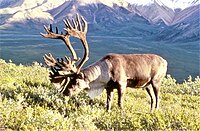
Photo from wikipedia
Migratory species display a range of migration patterns between irruptive (facultative) to regular (obligate), as a response to different predictability of resources. In the Arctic, snow directly influences resource availability.… Click to show full abstract
Migratory species display a range of migration patterns between irruptive (facultative) to regular (obligate), as a response to different predictability of resources. In the Arctic, snow directly influences resource availability. The causes and consequences of different migration patterns of migratory species as a response to the snow conditions remains however unexplored. Birds migrating to the Arctic are expected to follow the spring snowmelt to optimise their arrival time and select for snow-free areas to maximise prey encounter en-route. Based on large-scale movement data, we compared the migration patterns of three top predator species of the tundra in relation to the spatio-temporal dynamics of snow cover. The snowy owl, an irruptive migrant, the rough-legged buzzard, with an intermediary migration pattern, and the peregrine falcon as a regular migrant, all followed, as expected, the spring snowmelt during their migrations. However, the owl stayed ahead, the buzzard stayed on, and the falcon stayed behind the spatio-temporal peak in snowmelt. Although none of the species avoided snow-covered areas, they presumably used snow presence as a cue to time their arrival at their breeding grounds. We show the importance of environmental cues for species with different migration patterns.
Journal Title: Scientific Reports
Year Published: 2020
Link to full text (if available)
Share on Social Media: Sign Up to like & get
recommendations!